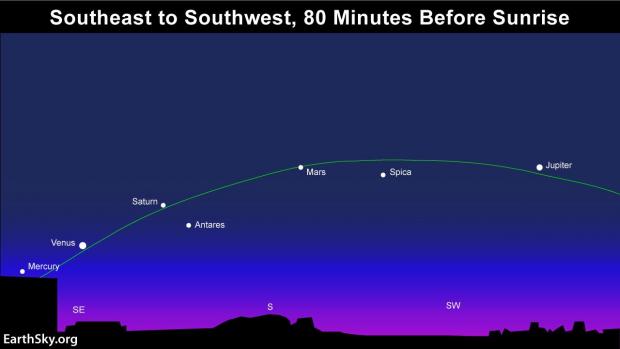When were the planets discovered? Uranus and Neptune were definitely not found until modern science began, since a telescope was required to see them. The other five planets were not actually discovered per se. Since they are visible to human eyes, they have been observed since prehistoric times, and we see examples of cultures across the ancient world who observed them. The five visible planets are Mercury, Venus, Mars, Jupiter, and Saturn. Starting this weekend, you can see them all across one part of the sky, a visual alignment that hasn’t occurred since 2005.

Planets are so-named because of the Greek word planets, meaning ‘wanderers.’ Even our ancestors knew that some of the lights in the sky seemed to move differently than the stationary pattern of stars. They were eventually named after gods, and would influence the naming of the days of the week:
Monday – Moon
Tuesday – Mars
Wednesday – Mercury
Thursday – Jupiter
Friday – Venus
Saturday – Saturn
Sunday – The Sun
The alignment isn’t anything special, so don’t expect the world to end. It’s what we call a visual alignment, where the observers are at the right place at the right time and all the planets are into the right part of their orbits for us to see them strung along an imaginary line in space.

It allows a lot of people to see the planets and compare how bright the planets are. Venus will be the brightest since it is close and highly reflective, Jupiter is big and bright, but far away and so it will be second. Mars and Mercury can interchange, but during the alignment Mercury will be magnitude zero, a bit brighter than Mars at +0.8. As the year progresses Mars will brighten up to Magnitude -2.1, but that will happen slowly until May. Saturn stays at +0.6, brighter than Mars but dimmer than Mercury during the alignment.
Watch out for bright stars as well. Blue Spica and red Antares are very bright, at +0.9 and +0.96 respectively. Antares is known as the rival of Mars, in mythology and in the sky. Mars is the Roman god of War and Antares is literally the anti-Aries, Aries being the Greek god of war, so they are rivals. Both being red in colour and similar in magnitude makes it easy to confuse them, so how can you tell the difference? The secret is in the twinkling. Antares is a star that is immensely far away, so it has a small angular size, and the movement of air in the atmosphere distorts it’s light, causing the twinkling effect we see. Mars on the other hand is a planet, much closer than any star, and with a larger angular size in the sky, making it more difficult for moving air to distort it’s light. the short answer becomes that planets don’t appear to twinkle very much if at all.
So get up early and see some planets, especially the tough ones, and discover them for yourself. Get some binoculars or a telescope, grab a hot drink, dress warmly, and go see the planets that your ancestors have been pondering for millennia.
